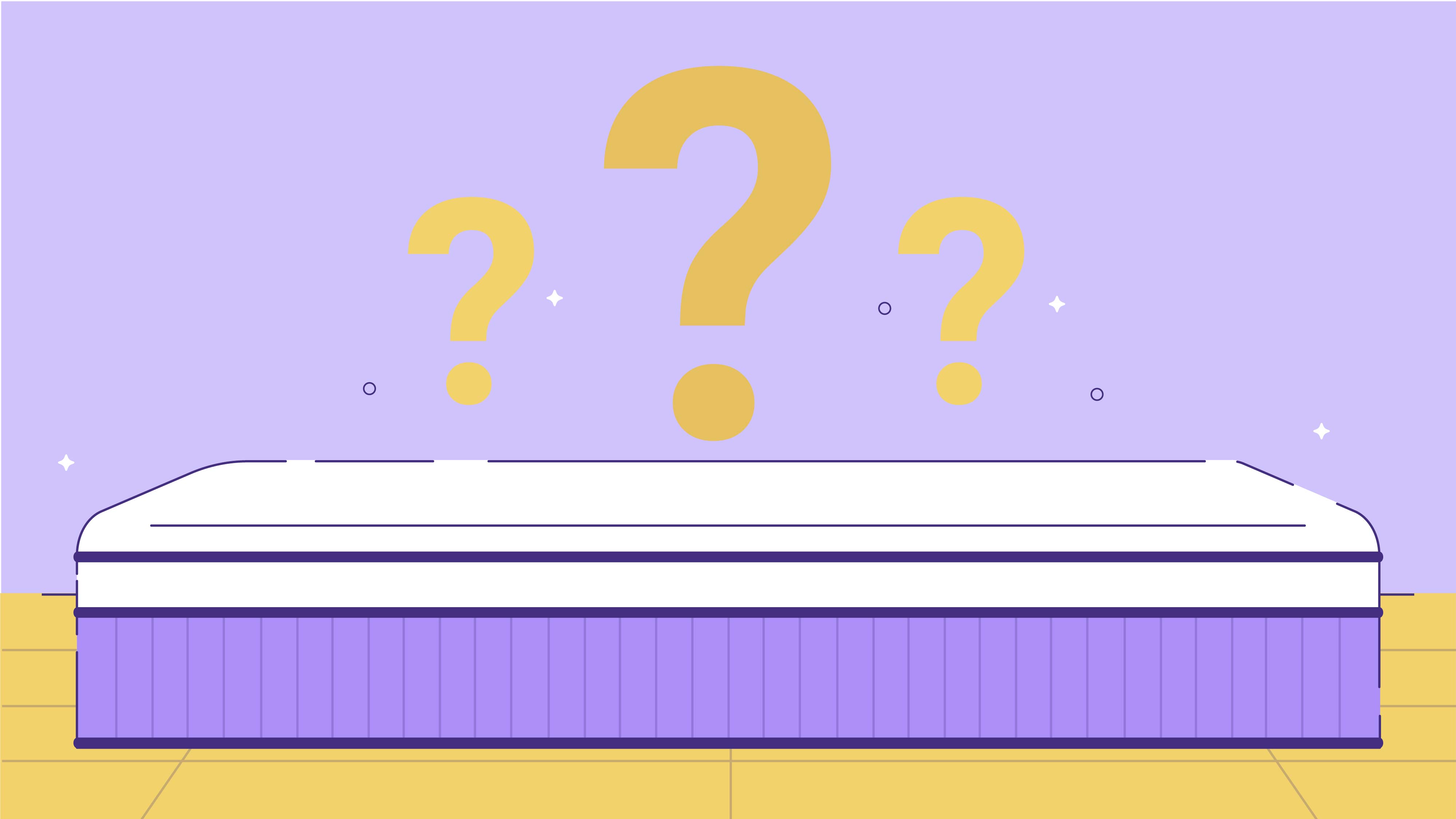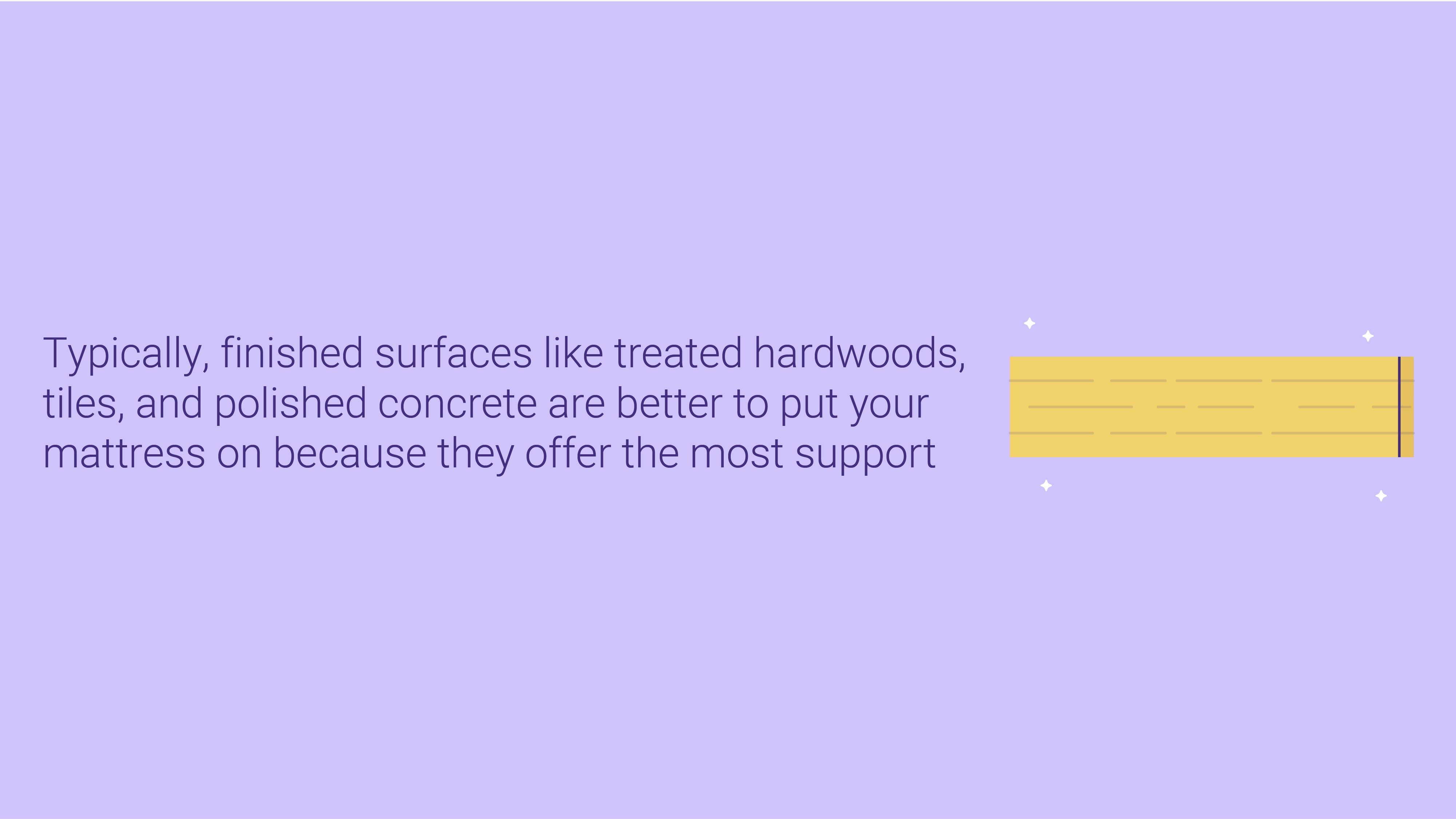
Can You Put a Mattress on the Floor?

- Placing a mattress on the floor can be an affordable solution, saving money on additional bedroom items like foundations and frames. It’s particularly advantageous for those in smaller living spaces, eliminating the need for bulky headboards and footboards and creating a clutter-free environment.
- Sleeping closer to the floor can provide a cooler environment, especially beneficial for hot sleepers. Additionally, a firm surface on the floor may offer relief for back pain, as suggested by some studies, promoting stability and reducing the risk of conditions like scoliosis.
- Despite the advantages, placing a mattress on the floor comes with potential drawbacks. Warranty issues may arise as many mattress warranties require specific bases. Infestations, exposure to dust, heat, and moisture retention are concerns.
Typically, mattresses are placed on foundations, bed frames, or box springs to lift them off the ground and enhance your sleep. While we don’t recommend placing your mattress on the floor, it is still an option.
Some people choose to sleep on the floor to save money when their budget is tight. For others, putting their mattress on the floor provides them with a cooler sleeping environment. On the other hand, this can also come with some serious drawbacks that may outweigh the advantages.
In this article, we’ll discuss the advantages and disadvantages of sleeping on the floor. We’ll also offer some tips to protect your mattress if you’re placing it on the ground.
Advantages of Placing Your Mattress on the Floor
Though there are some advantages to putting your mattress on the floor, you still need to keep a couple of things in mind. For instance, some mattresses may be better suited to use on the floor than others. Typically, air mattresses are the best for the floor since they are designed to maximize comfort for extra guests. Innerspring mattresses are also a good choice because they provide good airflow to your bed.
Now let’s take a look at some of the pros of putting your mattress on the floor.
Affordability
Investing in a new mattress can be pretty pricey, and depending on the type of mattress you have, purchasing a foundation can be just as expensive. So, putting your mattress on the floor can be an inexpensive solution. You may be able to save hundreds of dollars by waiting to invest in additional bedroom items like footboards and headboards.
Saves Space
For those who live in smaller apartments or bedrooms, a foundation can make your living area feel cluttered. Not to mention, headboards and footboards are bulky, and moving them around may be a struggle. It might be better to eliminate the use of these items to keep your bedroom clutter-free.
Cooler Sleeping Environment
Hot air rises naturally, so the closer you are to the floor, the cooler you may feel. Night sweats or an increase in body temperature can often account for restless sleeping and frequent wake-ups throughout the night. A colder sleeping environment may keep you comfortable at night, benefit your respiratory system, and improve your overall blood flow.
Back Pain Relief
Sleeping on a firm surface can be beneficial for easing neck and back pain. According to Harvard Medical School, putting your mattress on the floor may offer relief for people with lower back pain because it increases the mattress’s stability and firmness. This may also lower the risk of developing scoliosis, a neuromuscular condition.
It’s important to remember sleeping on the floor is not a cure-all for pain relief. Other factors like your sleeping position or pre-existing conditions may contribute to the level of pain you’re experiencing.
Potential Problems of Placing Your Mattress on the Floor
You may run into some issues if you decide to sleep with your mattress on the ground, such as pests and bugs infiltrating your sleeping space. Though there are some advantages to floor mattresses, most of them are outweighed by the negatives. Below, we’ll take a look at how some of the drawbacks can permanently damage your mattress.
Warranty Issues
In many cases, floor sleeping will void your mattress warranty. The truth is, your mattress is at a greater risk of being damaged when it is on the floor. Most mattress companies outline the base or foundation required to maintain the quality of your mattress. Choosing to disregard this policy can void your warranty altogether.
Though all manufacturers do not have bed frame requirements for their mattresses, they may still refuse to cover damages resulting from floor sleep. Since lying on the floor increases the likelihood of sagging, you may end up spending more money to replace your mattress than you would be purchasing a foundation.
Infestations
When your mattress is on the floor, it is a lot easier for bugs and pests to make their way onto sheets and pillows. Bed bugs like to hide in carpet fibers or between the planks of hardwood floors, and so your mattress may become infested with pests if bugs enter your home.
Exposure to Dust
Another disadvantage of sleeping on the floor is being exposed to dust that accumulates on the ground. Inhaling dust and other dirt particles can leave a permanent mark on your health and cause allergic reactions.
Frequently cleaning your sleeping area or vacuuming may help keep out some dust. However, you may want to consider using a foundation, especially if you have respiratory issues or allergies. This is especially true if you’re choosing a hypoallergenic mattress that you’ll want to keep clean and pristine.
Heat and Moisture is Trapped Under Mattress
The great thing about using a bed frame is it releases heat from the bottom of the mattress. When your mattress is directly on the floor, it prevents air from escaping, causing moisture to build up. With heat and moisture trapped inside your mattress, it’s quite common for mold or mildew to develop, causing permanent damage or musty smells to persist.
Difficulty Getting In and Out of Bed
Since your bed is at floor level, you’ll need to use more flexibility and strength to get in and out of bed, and it can be a struggle for those with joint pain or limited mobility to climb into bed safely. Purchasing a mattress foundation may be a better choice because they keep your bed at an accessible height. This way, you’ll be able to lie down in your bed without squatting or having to crouch over your mattress.
Tips for Using a Mattress on the Floor
If the disadvantages of sleeping on the floor haven’t convinced you to invest in a foundation or a bed frame, you’ll need to keep a few things in mind before you place your bed on the floor. Below, we’ll take a look at some ways you can protect your high-quality mattress and your body while sleeping on the floor.

Create a Clean Space
Keeping your sleeping space clean should be your number one priority if you are sleeping on the floor. Like we previously stated, beds closer to the ground accumulate dirt and dust more easily. Though there is no way to eliminate dust from building up on your mattress, it’s still best to use a vacuum cleaner regularly.
We also suggest leaning your mattress against a wall or table for a few hours every week to air out your bed. However, this means you’ll be lifting your mattress frequently, which can be extremely difficult for shorter individuals and those lacking strength.
Consider the Flooring Material
Typically, finished surfaces like treated hardwoods, tiles, and polished concrete are better to put your mattress on because they offer the most support. Placing your mattress on natural carpeting or unfinished wood can ruin your mattress since these surfaces tend to retain more moisture than others. It can also cause your bed to smell and increase the risk of mold growth.
Use Barrier Between the Mattress and the Floor
It may be a great idea to consider placing a barrier under your mattress. You can use a bunkie board, Japanese tatami mat, or any thin breathable material to help create a buffer between your mattress and the dust or dirt on the floor.
Bunkie boards are pretty affordable but are typically only 2-3 inches thick. Even though they can offer additional support for your mattress, they cannot completely protect your mattress from dirt and dust mites. We also suggest using a mattress protector to prevent irritants like bed bugs and mold from damaging your bed.
FAQS
What type of flooring should I put a mattress on?
It’s best to set your mattress on hard surfaces such as hardwood floors, tile, or tatami flooring. These surfaces offer the most support and stability and don’t retain as much moisture as natural fiber carpet or unfinished plywood. Usually, mattresses placed on a carpeted floor can increase the odds of mold growth and may cause your sleeping area to smell a bit musty.
How thick should my mattress be if I put it on the floor?
There is no requirement for how thick your mattress should be if you’re placing it on the ground. However, we suggest using a 12 inch mattress or thicker. Since the floor is much harder than a box spring or a platform bed, a mattress with this thickness may offer more comfort.
How should I prepare to put my mattress on the floor?
Keeping your mattress in a clean area is essential if you’re placing a mattress on the floor. We suggest thoroughly cleaning your carpet or flooring to ensure all dust or pests are removed from your sleeping area. You should also consider investing in a mattress protector to shield your mattress from bugs and moisture while it’s on the floor.
Is placing a mattress on the floor bad for your back?
Some researchers believe sleeping on firm surfaces, like hardwood floors may reduce back pain and the risk of developing scoliosis. However, this all depends on factors like the cause of your pain or sleeping position. Additionally, other sources do not recommend sleeping on the floor for back pain relief.
Should I use a barrier or a bunkie board between my mattress and the floor?
Using a barrier between your mattress and the floor can be helpful. Bunkie boards, tatami mats, and other flat surfaces can help provide a buffer between your mattress and the dust and dirt accumulating on the floor. However, it’s important to remember there is no one way to keep your mattress squeaky clean while it is on the floor.
Conclusion
Though there are some advantages of placing your mattress on the floor, it’s safe to say the bad outweighs the good. It’s better to invest in a platform bed or mattress foundation since these items provide proper support for your bed.
If you cannot make this purchase, you’ll want to take the necessary precautions to keep your space clean. It’s also a good idea to use a bunkie board to create a barrier between your mattress and the ground. This may help keep dust and dirt from accumulating on your mattress and create a comfortable sleeping environment.
